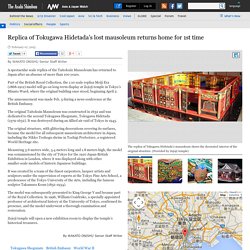

Replica of Tokugawa Hidetada’s lost mausoleum returns home for 1st time. A spectacular scale replica of the Taitokuin Mausoleum has returned to Japan after an absence of more than 100 years.

Part of the British Royal Collection, the 1:10 scale replica Meiji Era (1868-1912) model will go on long-term display at Zojoji temple in Tokyo’s Minato Ward, where the original building once stood, beginning April 2. The announcement was made Feb. 5 during a news conference at the British Embassy. The original Taitokuin Mausoleum was constructed in 1632 and was dedicated to the second Tokugawa Shogunate, Tokugawa Hidetada (1579-1632). It was destroyed during an Allied air raid of Tokyo in 1945. The original structure, with glittering decorations covering its surfaces, became the model for all subsequent mausoleum architecture in Japan, including the Nikko Toshogu shrine in Tochigi Prefecture, a registered World Heritage site.
The model was subsequently presented to King George V and became part of the Royal Collection. DigiVol: A Game of Kai-Awase Anyone? Blog home By: Leonie Prater, Category: Museullaneous, Date: 20 Mar 2013 A painted clam shell from Japan in Malacology caught our imaginations and led to some creative story telling by DigiVol.

Ron Lovatt © Australian Museum For over a year, volunteer digitisers have been busily digitising a range of molluscs, including chitons, mussels, snails, tusk shells and clams. We have seen some amazing shells from micro shells invisible to the naked eye to the beauty of large nautilus shells but when we came across a painted decorative clam shell nestled in amongst the standard clams, we were inspired to find out more about it. Our starting point was to check the early Australian Museum register to see what information could be gleaned from it and then to drawer on anecdotal information from Museum staff if available. Consequently, an interested volunteer researched its possibilities and suggested that it could have been part of a game called Kai-awase.
Plectrum (bachi) for lute (shamisen) 19th century Dimensions Length 21.2 cm, width 8.2 cm, thickness 2.2 cm (Length 8 3/8 in., width 3 1/4 in., thickness 7/8 in.)

Accession Number Medium or Technique Ivory On View Musical Instrument Gallery (Gallery 103D) Collections Musical Instruments. An okegawa do tosei gusoku armour Late Edo Period, 19th century. A kawari hachi Early Edo Period, 17th century. Nagasone Tojiro Mitsumasa, helmet in the form of a... - Virtual Artifacts. Shunsho Katsukawa 1726-1792 - 100 Poems by 100... Five Celebrated Generals (Gobushô 五武将): Description. Yūshōin Niten Gate- Backside Aoi no Gomon. Call me crazy but I wish I lived in the samurai... - WOMBO COMBO!!!
Edo Period (1615-1868) (vocabulary) Fire emblem and sword psychiatry or whatever: Last Names in the Edo Period. Fire emblem and sword psychiatry or whatever: Fruitlessly, I searched the English web for Edo... The Staxx, Virtually every type of technique was utilized in... Strange Narratives : On a dark night, one puts a light on an andon... Untitled.